 |
|
A long
straight uphill section has to be climbed before the last curve
in front of the tunnel is reached. The turnout left belongs to the
southern in feed station for electrical energy (Transformer 110
kV to 15kV) (5/2004).
|
|
|
|
|
|
 |
|
The
map shows, immediately behind the Semmering station the main tunnel
chains on. Then the line descends and on the way to Muerzzuschlag
still two stations are passed any more, first Steinhaus and then Spital
am Semmering. (top of page) |
|
|
|
|
|
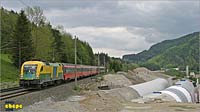 |
|
In
May 2004 this interstate highway section was still under construction.
Both highway tunnels were built crossing the Semmering line one
floor below. In the background right the highway portal. An Intercity
train headed by a Gysev Taurus is going downhill (5/2004).
|
|
|
|
|
|
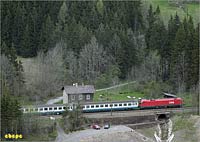 |
|
Of
course, the series of former rail attendant buildings continues
in the south too. Today they are used by private persons. In April
when the vegetation was still winter like, this image was taken
from an opposite slope. A bit delayed, train EN 234 "Allegro
Toska" passes this location at 7:50 on its way to Vienna (4/2005).
|
|
|
|
|
|
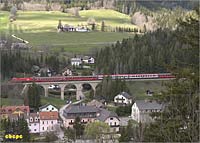 |
|
The
Steinhaus viaduct is the first track building downhill the south ramp
(also see title). The shot was made from a skiing hill opposite to
the viaduct. Unfortunately the main subject is shaded by a "photo
cloud"… (5/2005). (top of page) |
|
|
|
|
|
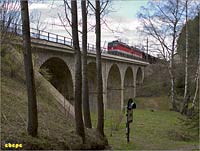 |
|
Once
again the Steinhaus viaduct, but from an opposite side view. A train
is on tour uphill. Between 1917 and 1958 a small 600 mm gauge forest
railroad was in steam operation here, transporting wood to the main
line. It first passed the arch in front, then turned left and reached
the former loading zone at the opposite end of the viaduct (5/2005). |
|
|
|
|
|
 |
|
Behind
Steinhaus the last of the impressive Semmering viaducts, the Holzergraben
viaduct is located. An intercity headed by class 1044 is going uphill.
Opposite to this viaduct a new interstate exit was built in 2004.
The old highway passes two of the viaduct's arches (5/2004). |
|
|
|
|
|
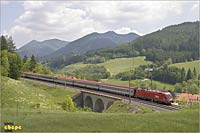 |
|
The Jauern viaduct bridges the Jauern creek. The mountains in the
background are the Sonnwendstein with the antennas left, then the
Erz- and Peterbauerkogel and finally the Hocheck at right. The train
will pass the Spital am Semmering station in a few minutes (6/2005).
(top of page) |
|
|
|
|
|
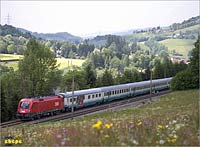 |
|
Despite
here the main object is shaded by a "photographic cloud"
too, one may easily recognise the changed landscape style compared
with the north ramp. "Allegro Stradivari" from Venice passes
a construction section and some of the passengers maybe enjoy the
colourful meadows when passing (6/2005). |
|
|
|
|
|
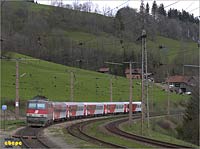 |
|
Like
many other stations, the Spital am Semmering station is equipped
with 3 tracks. A commuter train which had stopped here is starting
uphill this moment. Steering of the loco at train's end is performed
remotely from the front carriage (6/2005). |
|
|
|
|
|
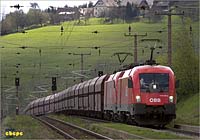 |
|
The
different scales of inclination between countryside and station area
are easily visible on this image, showing a freight train approaching
the Spital am Semmering station. The indirect illumination produces
some kind of dramatic impression (4/2005). (top of
page) |
|
|
|
|
|